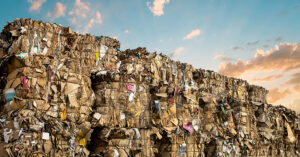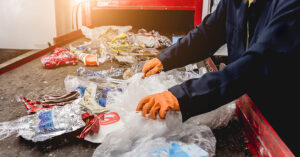Plastic waste is one of the most pressing environmental issues of our time.
For businesses, managing plastic waste efficiently is not only a responsibility but also an opportunity to enhance sustainability practices and operational efficiency.
Effective plastic waste management can lead to cost savings, improved brand image, and compliance with environmental regulations.
This guide aims to provide businesses with actionable strategies on what to do with plastic waste, focusing on reduction, reuse, and recycling, and how to implement these practices with the help of industrial recycling equipment like balers and compactors.
Understanding Plastic Waste
Types of Plastic Waste
To manage plastic waste effectively, it’s crucial to understand the different types of plastics that businesses commonly encounter:
- Polyethylene Terephthalate (PET): Commonly used for beverage bottles and food containers. It is widely recycled and has a high market value.
- High-Density Polyethylene (HDPE): Found in products like milk jugs and detergent bottles. Known for its strength and durability, HDPE is also highly recyclable.
- Polyvinyl Chloride (PVC): Used in pipes and vinyl flooring. PVC can be more challenging to recycle due to its chemical composition.
- Low-Density Polyethylene (LDPE): Used for plastic bags and six-pack rings. LDPE recycling rates are lower, but it can be repurposed into products like bin liners.
- Polypropylene (PP): Found in straws and bottle caps. PP is recyclable and can be turned into products like automotive parts.
- Polystyrene (PS): Used in disposable cups and insulation materials. PS recycling is less common due to its low density and economic viability.
Impact of Plastic Waste on the Environment
Plastic waste has significant environmental impacts:
- Pollution of land and water bodies: Plastics often end up in rivers, lakes, and oceans, contributing to pollution and harming marine life.
- Harm to wildlife: Animals can ingest plastic debris, leading to injury or death. Microplastics can also enter the food chain, affecting ecosystems and human health.
- Contribution to greenhouse gas emissions: The production and disposal of plastics release carbon dioxide and other greenhouse gases, exacerbating climate change.
Strategies for Managing Plastic Waste
Reducing Plastic Use
Reducing the use of plastics is the first step in managing plastic waste:
- Implementing waste reduction policies: Develop company-wide policies to minimize plastic use, such as banning single-use plastics and promoting alternatives.
- Encouraging the use of reusable materials: Switch to reusable items like metal straws, glass containers, and cloth bags.
- Redesigning products to minimize plastic content: Collaborate with product designers to reduce plastic components in your products.
Reusing Plastic Materials
Reusing plastics can significantly reduce waste and costs:
- Identifying opportunities for reusing plastic in operations: Evaluate your processes to find areas where plastic can be reused rather than disposed of.
- Creating partnerships with other businesses for plastic reuse: Network with other companies to exchange plastic materials for reuse.
- Innovative uses of plastic waste in new products: Develop new products using recycled plastics, such as outdoor furniture, construction materials, or packaging.
Recycling Plastic Waste
Recycling is a critical component of plastic waste management:
- Importance of proper segregation: Properly segregating plastic types is essential to avoid contamination and ensure efficient recycling.
- Separate different plastics into designated bins to prevent contamination.
- Implementing an efficient recycling program: Set up a comprehensive recycling program within your organization.
- Use labeled bins for different types of plastics.
- Conduct regular training for staff on recycling practices.
- Working with certified recycling facilities: Partner with recycling facilities that adhere to environmental standards to ensure your plastic waste is recycled properly.
The Role of Recycling Equipment
Industrial recycling equipment plays a vital role in managing plastic waste efficiently.
Balers
Balers compress plastic waste into dense, manageable bales:
- How balers work: Balers use hydraulic pressure to compress plastics into compact bales, making storage and transportation easier.
- Benefits of using plastic balers:
- Reduces the space needed for waste storage.
- Facilitates efficient transportation to recycling facilities.
- Increases the value of recyclable materials by reducing contamination.
Compactors
Compactors reduce the volume of plastic waste:
- Function of compactors: Compactors compress large volumes of plastic waste into smaller, more manageable sizes.
- Advantages of compactors for businesses:
- Lower waste disposal costs by reducing the frequency of waste collection.
- Improved workplace cleanliness and safety by minimizing clutter.
- Enhanced operational efficiency through better waste management.
Implementing a Comprehensive Plastic Waste Management Plan
Conducting a Waste Audit
A waste audit helps businesses understand their plastic waste generation:
- Assessing the types and quantities of plastic waste generated: Conduct a detailed analysis of the types and amounts of plastic waste your business produces.
- Identifying sources of plastic waste within the business: Determine the primary sources of plastic waste to target reduction and recycling efforts effectively.
Setting Clear Goals and Objectives
Define clear goals to guide your plastic waste management efforts:
- Defining short-term and long-term goals for plastic waste reduction: Establish specific, measurable goals for reducing plastic waste over time.
- Creating measurable objectives to track progress: Develop key performance indicators (KPIs) to monitor your progress towards achieving these goals.
Employee Training and Engagement
Engage employees in your plastic waste management program:
- Educating employees on the importance of plastic waste management: Conduct training sessions to raise awareness about the environmental impact of plastic waste and the importance of proper management.
- Providing regular training sessions on waste handling and recycling: Offer ongoing training to ensure employees are up-to-date on best practices for handling and recycling plastic waste.
Partnering with Recycling Experts
Collaborate with experts to enhance your plastic waste management program:
- Collaborating with recycling equipment suppliers: Work with suppliers like Nanoia Recycling Equipment to access high-quality recycling equipment and expertise.
- Seeking advice from industry experts on best practices: Consult with recycling professionals to stay informed about the latest trends and technologies in plastic waste management.
Nanoia Recycling Equipment: Your Partner in Plastic Waste Management
Nanoia Recycling Equipment offers comprehensive solutions for managing plastic waste:
- Overview of Nanoia Recycling Equipment’s comprehensive solutions: We provide end-to-end services, from design and fabrication to delivery, installation, finance, and repair.
- How Nanoia can help design, fabricate, deliver, and install recycling equipment: Our team of experts will work with you to create a customized recycling solution tailored to your business needs.
- Financing and repair services offered by Nanoia: We offer flexible financing options and reliable repair services to ensure your recycling equipment operates efficiently.
Encouragement to contact Nanoia for a custom solution:Reach out to Nanoia Recycling Equipment for a tailored solution that meets your specific requirements.






